White Daisies & Asters
The family Asteraceae is one of our largest plant families and contains - among others - the thistles, dandelions, daisies and sunflowers. This page largely deals with the members of the family that have flowers consisting of white petals with a yellow centre and which we often refer to as daisies, though here you will also find mayweeds, chamomiles, michaelmas-daisies and others. For ease, the descriptions here talk about 'flowers' but in this family, what appears to be a single flower is actually a cluster of several to many, tiny flowers that are often refered to as florets. The inner florets are often petalless, while those around the outside bear the petals, with the whole appearing to form a single flower. In the white daisies, the structure of the compound flowers is fairly similar, so here, these groups are mostly separated by differences in their leaves.
The main purpose of this page is to attempt to break this group up into bite-sized chunks, so that the pages you are led to do not get too big by containing a large number of species. At worst, if you follow a link from here and do not see your plant, return to this page and try another link. Note that some species may come in a variety of flower colours; in such cases, the species is shown on more than one page, so you should still find it.
At this stage, be sure to read the texts accompanying the pictures below carefully, as they contain identification information that may not be visible in the photographs; clicking to the next stage will help you get to the exact species. It is important with this family to not only look at flower colour but also to look at detail of the green outer part of the flower head, which is made up of overlapping segments called phyllaries.
Use the photos below to narrow your search to a group, then click on the picture to go to the next stage.
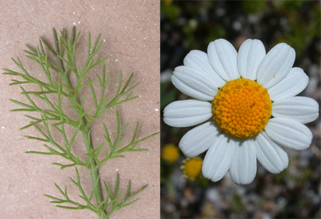 |
Mayweeds & Chamomiles
The main feature that identifies this group of daisy-like plants is the leaves, which tend to be deeply divided into very narrow, linear segments. These are typically rather low, often bushy plants or even creeping and mat-forming. The foliage often has a distinctive smell if rubbed. |
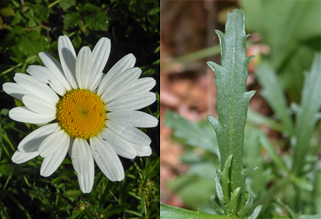 |
Ox-eye Daisies
Relatively tall (60cm or more) plants with stiff, upright stems. Leaves simple but often with toothed or deeply lobed margins. Flowerheads usually solitary at the ends of the stems. (Some flowers may be predominantly white, but with other colours also present.) |
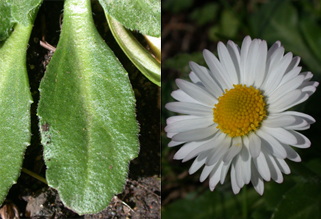 |
Daisies & Fleabanes
Relatively small (less than 60cm in height) plants with leaves on wiry stems or with leaves mostly in a basal rosette. Flowerheads usually solitary at the ends of the stems. Petals may be entirely white, or with other colours also present. |
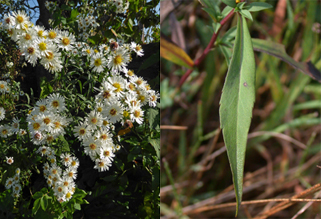 |
Asters and Michaelmas-daisies
The flowerheads in this group are made up of florets all of the same type, the florets in the middle simply having shorter petals than those around the outside. They closely resemble dandelion flowers, but each compound flower is much smaller than those of dandelions and the flowers are carried many at a time on much-branched stems. Basal leaves and stem leaves tend to be rather similar to each other, though the leaves generally get smaller towards the top of the stems; leaves often have soft spines along the midrib on the underside. Plants are usually at least 50cm tall and sometimes reach two metres or more in height! |
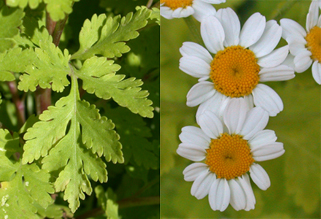 |
Feverfew
Plants 40-80cm in height, with yellow-green, chrysanthemum-like leaves on bushy stems. Flowerheads often double. |
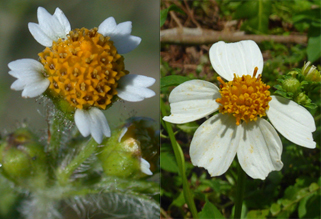 |
Few-petalled Daisies
A handful of white-flowered members of the daisy family have evolved to have many fewer petals around the outside of the compound flowerhead. In most cases, these plants have five petals but some individuals may have up to eight or so. They retain the cluster of yellow, petalless florets at the centre of the flowerhead and mostly have simple or three-parted leaves. |
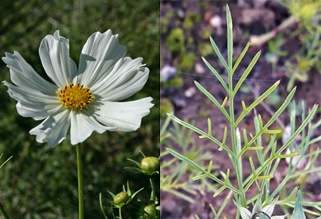 |
Few-petalled Daisies
A handful of white-flowered members of the daisy family have evolved to have many fewer petals around the outside of the compound flowerhead. In most cases, these plants have eight to 10 petals. They retain the cluster of yellow, petalless florets at the centre of the flowerhead and mostly have very fine leaves that are deeply cut into, linear segments. |